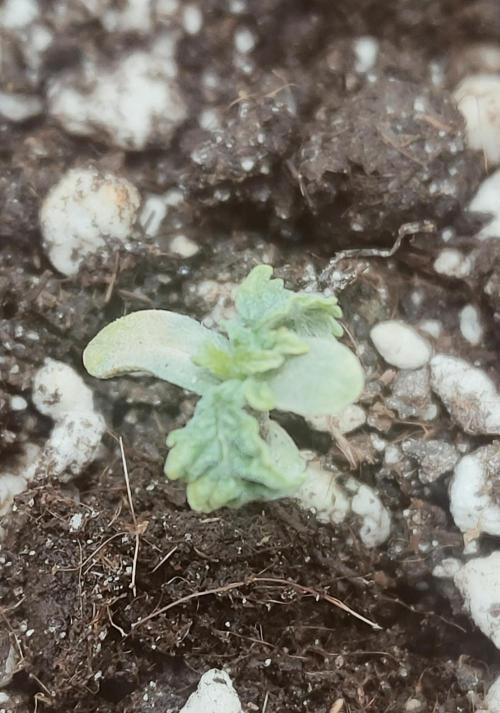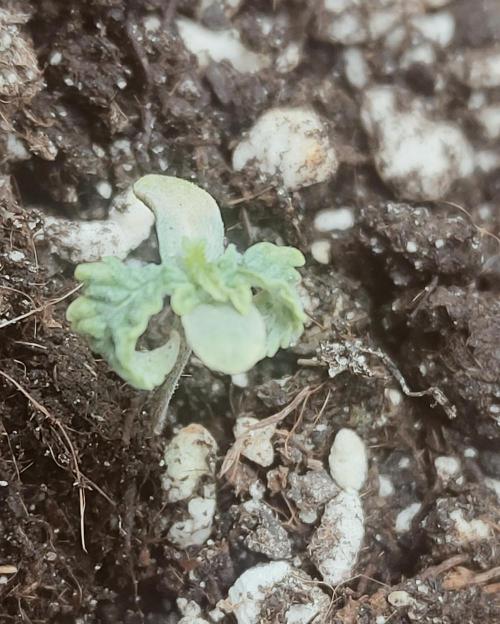By continuing to use the website or clicking Accept you consent to our cookies and personal data policy and confirm that you are at least 18 year old. For details please see Privacy Policy and Terms
Accept
2 week - slow grow & leaves down
Electrowenikstarted grow question 1mo ago
Hello gyus.
Houston, we need help - this girl (Gorilla autofem from 7ch) is 14 days and stopped growing with leaves twisted down.
Who had same issues? Tryed everything - much/less water (carefully!), light lower/higher.
Temperature keeping +24 with 60-70% hum, light 18/6.
Open
Leaves. Curl down
Plant. Too short
likes
Answer
Terpy_Burpzanswered grow question 22d ago
Cotyledon is browning off, mutated leaf structure, stunted growth all signs of Fungus Gnat Larvae. Gosh some people waffle on. Trust your gut, sadly on here you have to filter through the bullshit and peoples egos to find the gemstones of advice worth actually keeping mate, and when someone puts their ego over your grow its says volumes. There is silent and not so silent dick waving festivities going on on this Help section. Generally the ones who go on too much are the ones that are full of shit. A pretty good measure for life actually. I genuinely hope you sort your plant. A teaspoon of ground tumeric powder dissolved into water is the best natural deterrent of nasty soil Bourne bugs like fungus gnats and the likes. Do check my diaries just to be sure im not full of shit myself. You got to stay on your toes around here. All the best to you and fuck the rest of the know it all circle wanking dick wavers!
likes
Complain
Organomananswered grow question 25d ago
Not all seeds make it......some are duds.........this is a dud seed!
likes
Complain
Autolover76answered grow question 25d ago
Hey m8. That seedling looks like it stopped growing at about 3/4 days old likely because it was a runt.. a bad seed.. the twisted up gnarly leaves say that to me. My guess is that it wouldn't have mattered what you did this seedling was doomed. Ive seen it many times. Aside from that the yellowing on the few days growth you did get suggests your ph was off and the seedling wasn't picking up what it needed from the soil. If you haven't scrapped it then you should, no harm intended, it is not going to grow into a plant. Start again. I have quite a few grows under my belt but only 1 on here. Happy to help you out if you want.
likes
Complain
00110001001001111Oanswered grow question 1mo ago
you've got 3 nodes tightly packed together --- reduce light.
it may take time to recover, and when it does you may need to adjust the light some more... until it matures and can settle in with 'max' dli for your local variables.
In future, take note of light power, distance etc.. map out a safe way to ramp up the light as the seedling asks for it (stretch). you can avoid the excess stretch 'next' time with a good plan. If a plant gets stunted by light, it can take a while to snap out of it and resume growing normally, fyi. Just have to observe and react when it does.
node spacing is a guide to light intensity. Seedlings need less, but will quickly show you they need more if they stretch. if nodes don't space out at all, you know you are giving too much light. It's just something you'll have to learn by doing. As with most things it's not about 'giving more' ... it's about a happy zone in the middle.
No matter the recommendation or the source, always allow the plant in front of you to dictate reality and how to react. Node spacing guides light intensity. LEaf symptoms guide fertilization. etc etc... recommendations are a good starting point but always adjust to the plant in front of you. Great recommendations merely reduce trial and error required. It is always required.
Your VPD (temp and RH need to be considered together, not seperately) is fine. This is not the cause. So, 99.9999999% certain it's the light being too intense.
A wonky VPD can reduce how much light a plant can handle per day (DLI). 70% RH is probably going a bit high, though. You want RH at 65 and below and appropriate temperatures that equate to a proper VPD for stage of life. Over 65% elevates microbial risks. Short-term events of high rh are less concerning but should still be avoided. (rooting clones is a different animal in this regard... high rh is a necessary risk for cuttings)
2 likes
Complain
Brujo_grdnanswered grow question 1mo ago
Hello 👏
First of all, I recommend checking water Ph, probably there is some displacement. If you have land = make Ph 7-8.
And the second - the plant lacks a good climate around.
Take a plastic container from under meals, transparent, make holes in it, put a container on top of the plant.
And drink there from the pulvizer/ spray just water = to maintain high humidity.
In this way, I restored many plants at the first stages of growth.
With a container with holes from above - you need a few days to restore strength and strongly.
Water the plant very neatly, very in small volumes of water, and preferably around the plant so that the roots grow in width.
Water a small amount of water in 0.050 ml. 1 time in 2 -3 days. All the rest of the time - raise the installed cover - a container and puff 1 -2 - 3 times a day on the walls of this container - cover.
The container should be very transparent. With holes.
And within a few days, the plant should become stronger and begin recovery and healthy growth.
Good luck and good growth🙌
1 like
Complain
AsNoriuanswered grow question 1mo ago
Last 3 question from 4 are about same thing.
Its watering, nute and humidity levels related. Very rare case - genetic mistake.
I grew not one.
Have a look at picky one ;)
growdiaries.com/diaries/278952-grow-journal-by-asnoriu
likes
Complain
Similar Grow Questions
Solved

BakedPanda
Seedling Leaves Drooping (8 days old)Hi,
Need some advice for my first grow.
Noticed today that the seedling's leaves are starting to droop, they were close to 180 degrees horizontal the day before and I have no idea what is going on.
Flushed the pot with water to check drainage, and waters passing through well
Leaves. Curl down
4y ago
2
5
Solved

purgen
Need tips/help with very very bushy plantPotted for almost 6 weeks, grows super super bushy (already has 12 branches (6 nodes?), branches are so short that I can't even LST them. I guess she grows like that because of her genetics but maybe there's a way how to 'fix' her? Topped once, strain RQS Triple G
Plant. Too short
Techniques. LST
3y ago
4
Solved

Sativa_Juice_Grows
Can anyone tell if this wind burn or something worse? Thanks in advanceyooo can anyone help me identify this problem.
Over night I started having some tacoing and some brown spots
on my 2 plants.
The first picture is my other plant the white widow
The video is of the blueberry. They both have the exact same
symptoms. HELP ME SAVE THEM DOC!
4y ago
6
Solved

dirtysmoothywater
10 weeks old small plantsAm I getting enough sun?Week 9
Plant. Too short
5y ago
1
Solved

GVHBV
por qué puntas amarillas? dia 25HOLA
hace dos semanas comenzaron a ponerse amarillas las puntas
PH 6
Enraizante 1 vez a la semana 1 ml (deeper underground)en 1L
Y delta 8 primera aplicación 4ml en 1L
Le doy de comer dependiendo si el sustrato esta seco o no
( generalmente cada 3 o 2 dias)
Humedad 50-60% temp 25
Plant. Too short
5y ago
1
Solved

rkomaaa
Help pls!!! something strange is happeningrh 50
day temp 25c
night temp 21
ph 6.2
runoff 6.4/5
i started light with nuts
Leaves. Curl down
Leaves. Dropping off
4y ago
3
2
Solved

Lordcrow
My plant seem to be stunnedMy plant has stopped growing, I know I made a lot of mistakes...😖 like the beginner that I am but I want to continue to give love to my plan😍
What can I do ?🙌
1-Flush all the nutrients that I shouldn't have mixed..ooopsii
2-Only straight water
3-Only use general hydroponicsWeek 2
Plant. Too short
2y ago
3
Solved

BiggaB
Leaves canoeingI have noticed canoeing on the leaves any suggestions as to what could cause this? I have been watering with tap water only with approximately 16hrs of daylight but I have been leaving it a windowsill overnight could the streetlights affect it? (Fan leaves bottom left reference)
Week 4
Leaves. Curl down
3y ago
7
3
Solved

Slash_Haze
LeafeCant uderstand why them looks this twisted
70 cm away 2x sp 150w is it overlight?
Or too much fertilizer?
Advanced nut ph perfect
1 ml/L micro
+ 0,7ml/L grow
Thanks in advance to who can help me !
Leaves. Curl down
Leaves. Veins - stay green
4y ago
2
3
Solved

omegaman101
Hello. Having some issues with mainly top leaves beginning to fold downwards at the sides. I am believing it to be under watering but would like some other opinions please.
Have been dealing with gnat issues and have also sprayed milk/bicarb to try help with these issues.
Thanks!Week 6
Leaves. Curl down
6y ago
1
1
Solved

z0laire
Burnt looking seedlingWhat's going on with my #2 seedling? I thought it could be light burn and raised my light by 4" but the odd coloration on the tips has gotten worse 18hr later. It also doesn't seem to be drinking whats in the coco yet so I'm cautious about feeding.
Leaves. Edges burnt
Leaves. Tips - Burnt
Leaves. Curl down
5y ago
2
3

























